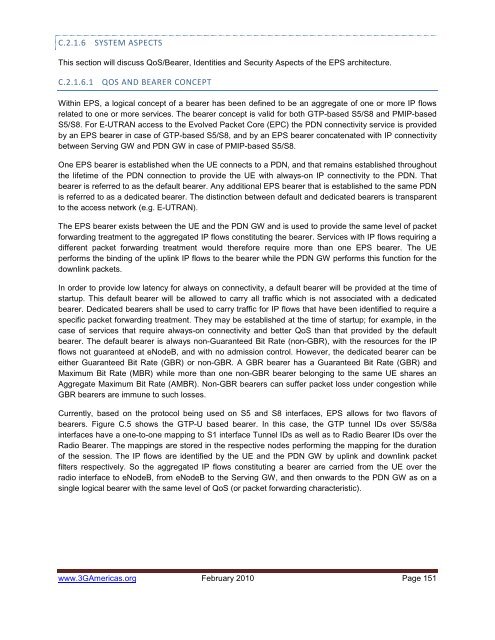UMTS: Alive and Well - 4G Americas
UMTS: Alive and Well - 4G Americas
UMTS: Alive and Well - 4G Americas
You also want an ePaper? Increase the reach of your titles
YUMPU automatically turns print PDFs into web optimized ePapers that Google loves.
C.2.1.6SYSTEM ASPECTSThis section will discuss QoS/Bearer, Identities <strong>and</strong> Security Aspects of the EPS architecture.C.2.1.6.1QOS AND BEARER CONCEPTWithin EPS, a logical concept of a bearer has been defined to be an aggregate of one or more IP flowsrelated to one or more services. The bearer concept is valid for both GTP-based S5/S8 <strong>and</strong> PMIP-basedS5/S8. For E-UTRAN access to the Evolved Packet Core (EPC) the PDN connectivity service is providedby an EPS bearer in case of GTP-based S5/S8, <strong>and</strong> by an EPS bearer concatenated with IP connectivitybetween Serving GW <strong>and</strong> PDN GW in case of PMIP-based S5/S8.One EPS bearer is established when the UE connects to a PDN, <strong>and</strong> that remains established throughoutthe lifetime of the PDN connection to provide the UE with always-on IP connectivity to the PDN. Thatbearer is referred to as the default bearer. Any additional EPS bearer that is established to the same PDNis referred to as a dedicated bearer. The distinction between default <strong>and</strong> dedicated bearers is transparentto the access network (e.g. E-UTRAN).The EPS bearer exists between the UE <strong>and</strong> the PDN GW <strong>and</strong> is used to provide the same level of packetforwarding treatment to the aggregated IP flows constituting the bearer. Services with IP flows requiring adifferent packet forwarding treatment would therefore require more than one EPS bearer. The UEperforms the binding of the uplink IP flows to the bearer while the PDN GW performs this function for thedownlink packets.In order to provide low latency for always on connectivity, a default bearer will be provided at the time ofstartup. This default bearer will be allowed to carry all traffic which is not associated with a dedicatedbearer. Dedicated bearers shall be used to carry traffic for IP flows that have been identified to require aspecific packet forwarding treatment. They may be established at the time of startup; for example, in thecase of services that require always-on connectivity <strong>and</strong> better QoS than that provided by the defaultbearer. The default bearer is always non-Guaranteed Bit Rate (non-GBR), with the resources for the IPflows not guaranteed at eNodeB, <strong>and</strong> with no admission control. However, the dedicated bearer can beeither Guaranteed Bit Rate (GBR) or non-GBR. A GBR bearer has a Guaranteed Bit Rate (GBR) <strong>and</strong>Maximum Bit Rate (MBR) while more than one non-GBR bearer belonging to the same UE shares anAggregate Maximum Bit Rate (AMBR). Non-GBR bearers can suffer packet loss under congestion whileGBR bearers are immune to such losses.Currently, based on the protocol being used on S5 <strong>and</strong> S8 interfaces, EPS allows for two flavors ofbearers. Figure C.5 shows the GTP-U based bearer. In this case, the GTP tunnel IDs over S5/S8ainterfaces have a one-to-one mapping to S1 interface Tunnel IDs as well as to Radio Bearer IDs over theRadio Bearer. The mappings are stored in the respective nodes performing the mapping for the durationof the session. The IP flows are identified by the UE <strong>and</strong> the PDN GW by uplink <strong>and</strong> downlink packetfilters respectively. So the aggregated IP flows constituting a bearer are carried from the UE over theradio interface to eNodeB, from eNodeB to the Serving GW, <strong>and</strong> then onwards to the PDN GW as on asingle logical bearer with the same level of QoS (or packet forwarding characteristic).www.3G<strong>Americas</strong>.org February 2010 Page 151
















